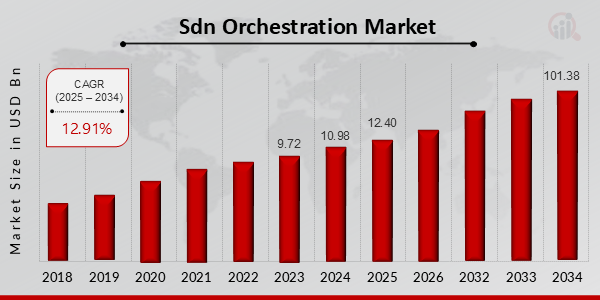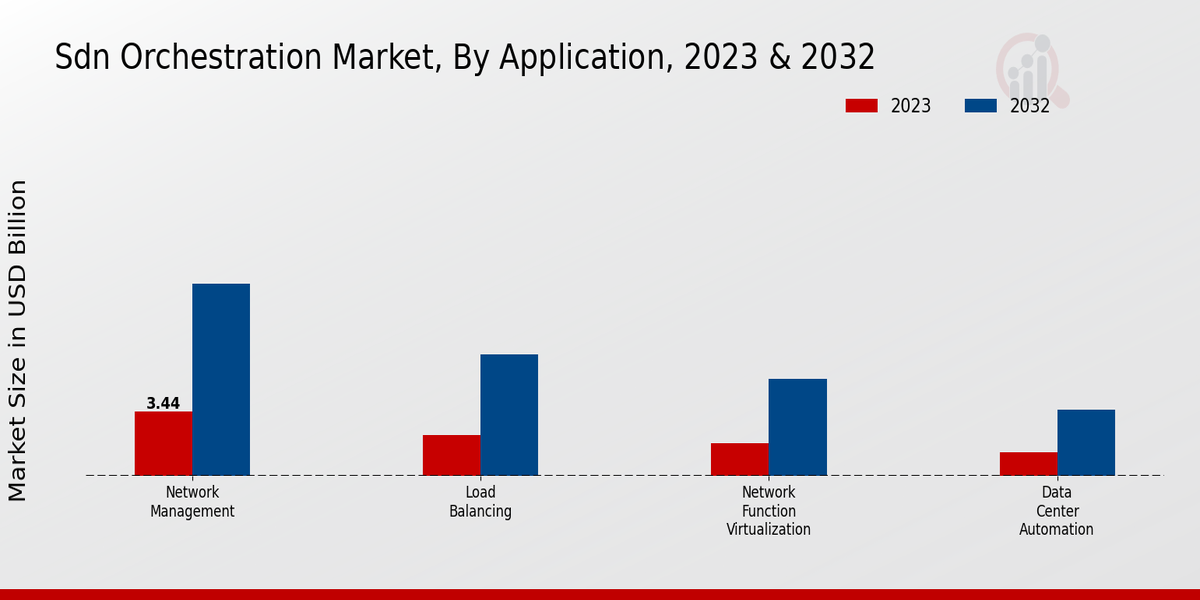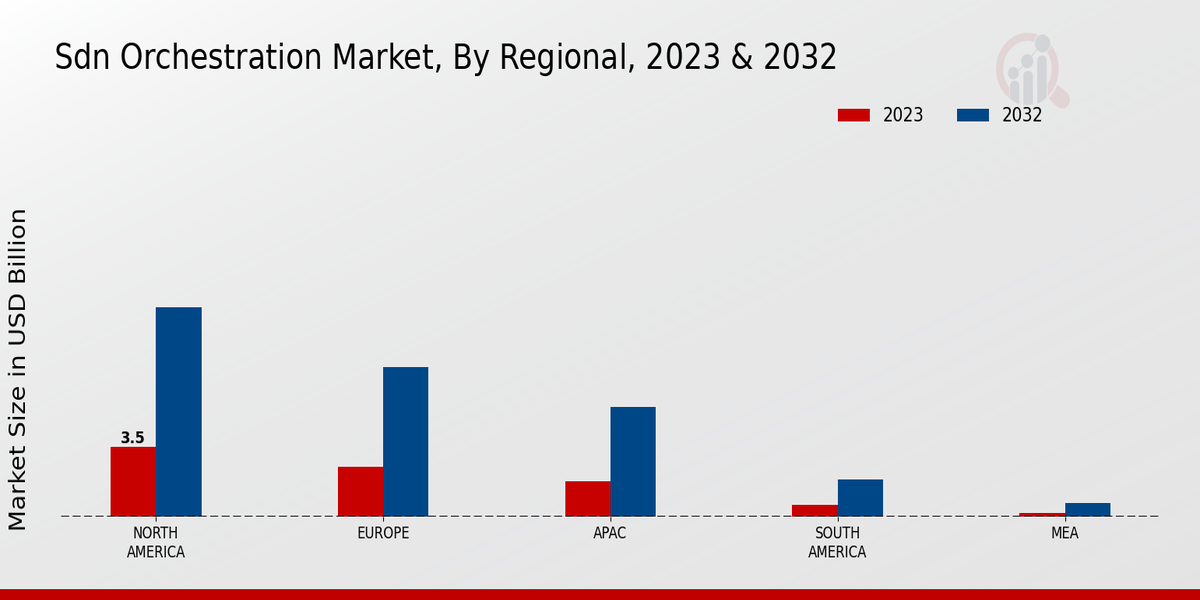SDN Orchestration Market Overview
Sdn Orchestration Market is projected to grow from USD 12.40 Billion in 2025 to USD 36.99 Billion by 2034, exhibiting a compound annual growth rate (CAGR) of 12.91% during the forecast period (2025 - 2034).
Additionally, the market size for Sdn Orchestration Market was valued at USD 10.98 billion in 2024.
Key SDN Orchestration Market Trends Highlighted
The SDN Orchestration Market is experiencing robust growth driven by the increasing demand for network automation and the need to simplify network management. Organizations are seeking solutions that allow them to manage their networking resources more effectively, enabling greater flexibility and efficiency. The rise of cloud computing and the growing trend toward virtualization are also significant factors contributing to this market expansion. As more businesses transition to cloud environments, the need for orchestration solutions that can efficiently handle dynamic workloads and ensure secure connectivity becomes increasingly critical.
Opportunities in the SDN orchestration market are abundant, particularly with the continued evolution of technologies such as artificial intelligence and machine learning. These technologies can enhance orchestration capabilities by allowing for predictive analytics and automated decision-making. Furthermore, the increasing adoption of IoT devices and edge computing creates new avenues for SDN orchestration solutions. Companies that can develop tools addressing these emerging needs are well-positioned to capture significant market share.
Recent trends indicate a shift towards open-source solutions in the SDN orchestration landscape, as organizations look for cost-effective ways to integrate various networking hardware and software. This movement toward open standards fosters collaboration and innovation within the industry. Additionally, the integration of security features into orchestration solutions has gained priority, as businesses are acutely aware of the importance of safeguarding their networks against evolving cyber threats.
As the market evolves, ongoing advancements in orchestration technology will continue to drive its growth and adoption across various sectors. Companies navigating this space must stay attuned to these developments to optimize their offerings and meet the demands of an increasingly digital world.
Figure 1 Sdn Orchestration Market Overview (2025-2034)

Source: Primary Research, Secondary Research, Market Research Future Database and Analyst Review
SDN Orchestration Market Drivers
Increasing Demand for Network Automation
The SDN Orchestration Market is experiencing substantial growth propelled by the increasing demand for network automation. Organizations across various sectors are recognizing the need for efficient network management and optimization.mWith the surge in data traffic due to the expansion of cloud services, the Internet of Things (IoT), and mobile applications, traditional network management practices are proving inadequate. SDN orchestration allows for the centralized management of network resources, enabling businesses to swiftly adapt to changing demands and improve their operational efficiency.
Furthermore, the implementation of automated solutions minimizes human errors, enhances response times for troubleshooting, and improves the overall performance of the networking infrastructure. Businesses are eager to harness these benefits, resulting in a robust push toward adopting SDN orchestration tools. As organizations strive to enhance their digital transformation efforts, the SDN Orchestration Market is set to flourish, fostering innovation and facilitating new business models that can better serve their customers.
Growing Need for Enhanced Security Protocols
As cyber threats continue to evolve and become increasingly sophisticated, there is a growing need for enhanced security protocols within network systems. The SDN Orchestration Market addresses this concern by providing advanced security features that allow for real-time monitoring and risk assessment of network activities. By utilizing software-defined networking, organizations can implement security measures that are not only more effective but also adaptable to dynamic threats. This flexibility is vital for safeguarding sensitive information and maintaining compliance with regulatory requirements, ultimately driving demand for SDN orchestration solutions.
Cost Efficiency and Resource Optimization
In an economic landscape where cost management is crucial, businesses are seeking solutions that offer cost efficiency and resource optimization. The SDN Orchestration Market responds to this need by maximizing resource utilization and minimizing operational costs. By streamlining network management processes, SDN orchestration enables organizations to allocate resources more effectively, reducing waste and enhancing overall productivity. This increase in operational efficiency not only leads to significant cost savings but also supports the scalability of IT resources as organizations grow. Consequently, the focus on cost efficiency has become a major driver for businesses to invest in SDN orchestration solutions.
SDN Orchestration Market Segment Insights
SDN Orchestration Market Application Insights
Focusing on individual applications, Network Management was the leading component, valued at 3.44 USD billion in 2023, and is projected to reach 10.38 USD billion by 2032, highlighting its critical role in maintaining network efficiency and reliability. This significant valuation indicates a majority hold in the market, as organizations increasingly rely on effective management tools to oversee complex network infrastructures. Load Balancing followed closely, valued at 2.18 USD billion in 2023 with expectations of growing to 6.54 USD billion by 2032.
Its importance is underscored by the critical need for distributing workloads evenly across servers, which ensures optimal resource utilization and enhances performance, thereby dominating a vital area of SDN orchestration.
Network Function Virtualization was valued at 1.73 USD billion in 2023 and has the potential to rise to 5.22 USD billion by 2032, reflecting its growing necessity in enabling the virtualization of traditional networking functions, which allows for greater flexibility and cost savings in network deployments. Lastly, Data Center Automation, valued at 1.26 USD billion in 2023 and expected to reach 3.56 USD billion by 2032, plays a crucial role as organizations look to automate their data center operations for improved efficiency and reduced operational costs.
The ongoing technological evolution and increasing demand for scalable, high-performing networks are key drivers fueling the growth across these application segments. The SDN Orchestration Market data indicates that as businesses prioritize agile and responsive network solutions, the adoption of these individual applications will continue to expand, fostering opportunities for innovation and development within the SDN orchestration framework.
Figure 2 Sdn Orchestration Market Type Insights (2023-2032)

Source: Primary Research, Secondary Research, Market Research Future Database and Analyst Review
SDN Orchestration Market Deployment Type Insights
The Deployment Type segment, comprising On-Premises, Cloud-Based, and Hybrid models, plays a crucial role in this market's expansion. The On-Premises deployment type remains a preferred choice for organizations prioritizing control and security, establishing a substantial foothold in the industry. Meanwhile, the Cloud-Based deployment is gaining traction due to its scalability and cost-effectiveness, appealing to businesses looking for flexible solutions. The Hybrid model combines both on-premises and cloud strategies, catering to organizations that require a blend of both for optimized management and performance.
As companies increasingly migrate to network virtualization and seek enhanced operational efficiencies, the SDN Orchestration Market data shows these deployment models contributing significantly to market growth. With evolving technological advancements and the demand for agile networking solutions, the market dynamics are favoring deployment strategies that adapt to changing business needs, positioning this segment prominently in the SDN Orchestration Market statistics.
SDN Orchestration Market End User Insights
The SDN Orchestration Market revenue is significantly driven by its end users, categorized into Telecommunication Service Providers, Cloud Service Providers, and Enterprises. Telecommunication Service Providers play a pivotal role, leveraging SDN orchestration to enhance network flexibility and reduce operational costs, which positions them as a dominant force in the market. Meanwhile, Cloud Service Providers are experiencing growth due to the increasing shift towards cloud-native architectures and the need for efficient resource management, making them another significant component of the SDN Orchestration Market.
Enterprises are also adopting SDN orchestration to improve their operational efficiencies and streamline workflows, contributing to the overall market dynamics. The convergence of these trends points to a positive outlook for the SDN Orchestration Market statistics, driven by technological advancements and the growing need for scalable network solutions. Challenges include the complexity of implementation and integration, yet the opportunities remain substantial as organizations seek to enhance their digital transformation efforts.
SDN Orchestration Market Component Insights
The Component segment, which includes Software, Services, and Hardware, plays a crucial role in shaping the overall industry landscape. Software components are critical for providing the necessary control and management functionalities required for efficient network orchestration. Meanwhile, Services such as implementation, consulting, and support enhance the ability of organizations to adopt SDN orchestration effectively. Hardware also holds significant importance as it enables the foundational infrastructure that supports software and services.
This diverse segmentation allows businesses to tailor their strategies according to specific needs and improves overall network agility. With industry trends leaning towards automation and the need for real-time data management, the importance of each component continues to grow, helping drive market growth. The expected growth from 2024 to 2032 reflects the increasing demand for more efficient and scalable network solutions, as organizations are focused on optimizing their resources. The SDN Orchestration Market revenue will benefit from these trends as the industry adapts to changing technological landscapes.
SDN Orchestration Market Regional Insights
The SDN Orchestration Market shows substantial growth across various regions, with North America leading with a valuation of 3.5 USD billion in 2023 and projected to rise to 10.5 USD billion by 2032, highlighting its majority holding in the market. Europe followed closely, valued at 2.5 USD billion in 2023 and expected to reach 7.5 USD billion in 2032, as it continues to invest significantly in digital transformation initiatives. The APAC region, while smaller at 1.8 USD billion in 2023, is projected to grow to 5.5 USD billion, driven by increasing demand for advanced networking technologies.
In contrast, South America, valued at 0.6 USD billion in 2023, and MEA, valued at 0.21 USD billion, represent the lower end of the spectrum, but both regions showed potential for growth as technology adoption increases. Together, these regions contribute to the overall dynamics of the SDN Orchestration Market, with trends indicating a push toward enhanced operational efficiency and scalability in network management solutions.
Figure 3 Sdn Orchestration Market Regional Insights (2023-2034)

Source: Primary Research, Secondary Research, Market Research Future Database and Analyst Review
SDN Orchestration Market Key Players and Competitive Insights
The SDN Orchestration Market is witnessing significant growth as organizations increasingly seek to enhance their network management through software-defined networking technologies. This market is characterized by a myriad of players, each offering diverse SDN orchestration solutions that cater to a variety of industries. The competitive landscape is driven by the need for businesses to increase operational efficiency, reduce costs, and improve network flexibility. Companies within this market are continuously innovating their offerings, exploring emerging technologies such as AI and machine learning to bolster their orchestration capabilities.
As the demand for scalable and adaptable networking solutions rises, competition among key players intensifies, pushing them to expand their service portfolios and enhance interoperability to meet the evolving needs of their customers. Microsoft, a formidable player in the SDN Orchestration Market, capitalizes on its robust cloud infrastructure and advanced analytics capabilities to deliver comprehensive orchestration solutions. The company's integration of SDN with its Azure cloud services not only provides seamless network management but also enhances performance and reliability.
Microsoft's significant investment in research and development empowers it to introduce innovative features that address the latest market demands. Furthermore, the strong brand recognition and extensive customer base of Microsoft enable it to forge valuable partnerships and integrate its orchestration services across multiple sectors. The company's commitment to enhancing user experience and operational efficiency establishes it as a leader, poised to meet the increasing requirements of modern networking. Ciena, on the other hand, brings its unique strengths to the SDN Orchestration Market with a focus on advanced packet and optical networking solutions.
Ciena excels in providing high-performance orchestration tools that enhance network visibility and flexibility. The company's deep expertise in network architecture and its open networking approach enables seamless integration with existing infrastructure, thus appealing to a wide range of customers looking to modernize their networks. Ciena's innovative approach, particularly in leveraging automation and analytics, allows for dynamic adjustment of network resources based on real-time demands. This adaptability not only streamlines operations but also improves service delivery and responsiveness. Ciena's commitment to advancing network capabilities through ongoing development reinforces its position as a respected competitor in the SDN orchestration landscape.
Key Companies in the SDN orchestration market Include
SDN Orchestration Market Developments
Recent news developments in the SDN Orchestration Market indicate a growing interest among major players like Microsoft, Ciena, Dell Technologies, and IBM to expand their portfolios through innovative solutions addressing network agility and automation.
VMware has been actively enhancing its cloud infrastructure capabilities, while Nokia and Huawei continue to push boundaries with advancements in 5G networks that leverage SDN technologies. Notably, Juniper Networks and Arista Networks have reported robust growth due to increasing demand for cloud services and optimized networking solutions.
In the realm of mergers and acquisitions, Cisco Systems’ recent acquisition activity signals a strategic alignment towards enhancing its SDN orchestration capabilities, facilitating improved service delivery for enterprises. The market is experiencing significant growth, driven by the migration towards cloud infrastructure, which is reshaping how networks are managed and orchestrated.
As legacy systems transition to more agile solutions, the collaboration and investments among these companies highlight the competitive landscape that is rapidly evolving, promising increased efficiency and flexibility in network management. The convergence of these factors is set to redefine operational standards within the SDN Orchestration Market.
SDN Orchestration Market Segmentation Insights
SDN Orchestration Market Application Outlook
- Network Management
- Load Balancing
- Network Function Virtualization
- Data Center Automation
SDN Orchestration Market Deployment Type Outlook
- On-Premises
- Cloud-Based
- Hybrid
SDN Orchestration Market End User Outlook
- Telecommunication Service Providers
- Cloud Service Providers
- Enterprises
SDN Orchestration Market Component Outlook
- Software
- Services
- Hardware
SDN Orchestration Market Regional Outlook
- North America
- Europe
- South America
- Asia Pacific
- Middle East and Africa
SDN Orchestration Market Report Scope
|
Report Attribute/Metric
|
Details
|
|
Market Size 2024
|
10.98 (USD Billion)
|
|
Market Size 2025
|
12.40 (USD Billion)
|
|
Market Size 2034
|
36.99 (USD Billion)
|
|
Compound Annual Growth Rate (CAGR)
|
12.91% (2025 - 2034)
|
|
Report Coverage
|
Revenue Forecast, Competitive Landscape, Growth Factors, and Trends
|
|
Base Year
|
2024
|
|
Market Forecast Period
|
2025 - 2034
|
|
Historical Data
|
2019 - 2023
|
|
Market Forecast Units
|
USD Billion
|
|
Key Companies Profiled
|
Microsoft, Ciena, Pluribus Networks, Dell Technologies, IBM, Nokia, Huawei, Juniper Networks, Arista Networks, Morpheus Data, VMware, Fujitsu, Pica8, NEC, Cisco Systems
|
|
Segments Covered
|
Application, Deployment Type, End User, Component, Regional
|
|
Key Market Opportunities
|
Increased cloud adoption, Growing demand for automation, Rising need for network scalability, Emergence of 5G technology, and Enhancements in cybersecurity solutions
|
|
Key Market Dynamics
|
Increasing network automation demand, Rising cloud adoption rate, Growing need for network efficiency, Expansion of IoT devices, and Enhanced focus on network security
|
|
Countries Covered
|
North America, Europe, APAC, South America, MEA
|
Frequently Asked Questions (FAQ):
The SDN Orchestration Market is expected to be valued at 36.99 USD billion by 2034.
The CAGR for the SDN Orchestration Market is expected to be 12.91% from 2025 to 2034.
North America held the largest market share, with a value of 3.5 USD billion in 2023.
The Network Management application is projected to be valued at 10.38 USD billion by 2032.
Key players include Microsoft, Ciena, Dell Technologies, IBM, and Cisco Systems, among others.
The Load Balancing application was valued at 2.18 USD billion in 2023.
The APAC region is anticipated to grow significantly, projected to reach 5.5 USD billion by 2032.
The Data Center Automation application was valued at 1.26 USD billion in 2023.
The Network Function Virtualization application is expected to reach a value of 5.22 USD billion by 2032.
The market size in South America is expected to grow to 1.9 USD billion by 2032.

















